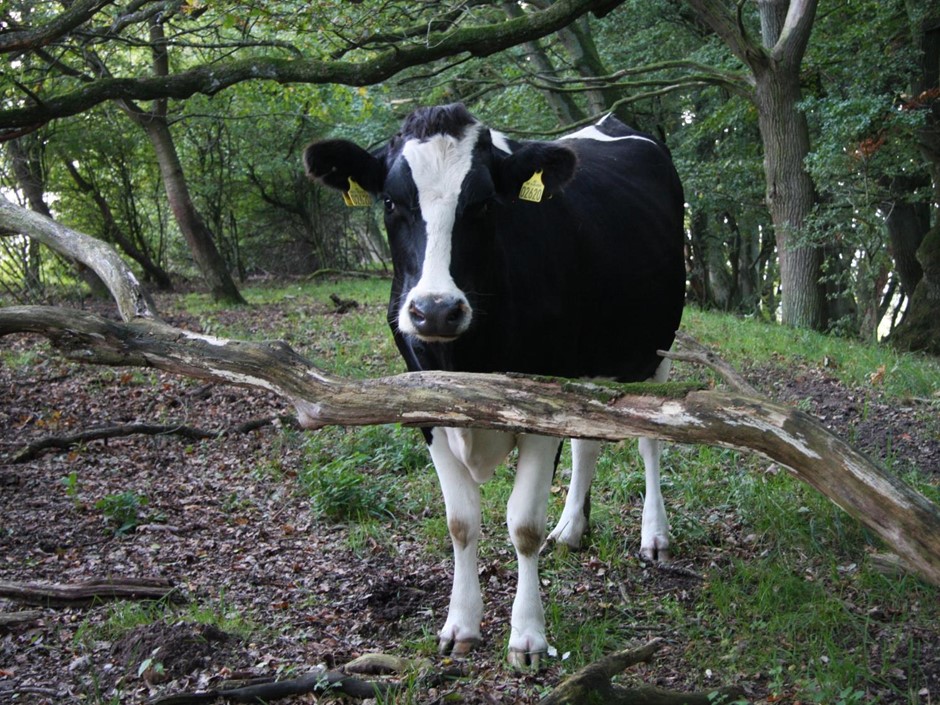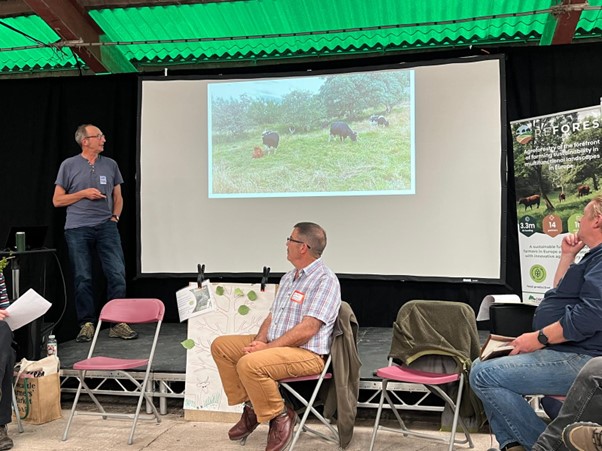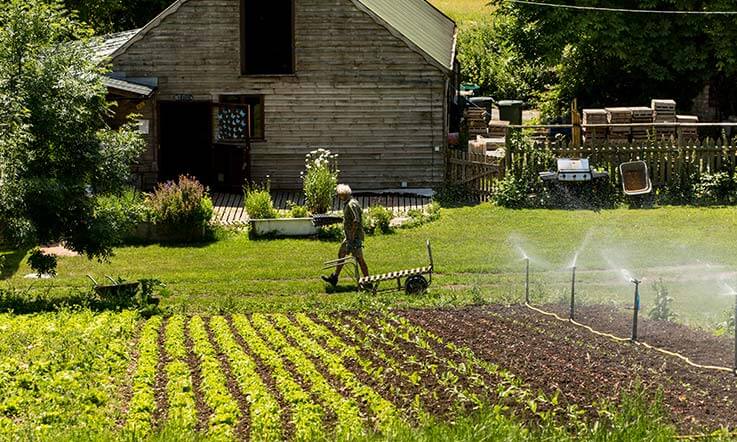As part of the ReForest North of England Living Lab the Organic Research Centre (ORC) ran a workshop at Carbon Calling. ‘Trees and Livestock: a balancing act’, was a discussion between Dr Lindsay Whistance, Senior Livestock Researcher at the ORC, Rick Cooper of Low Skelgill Farm, and Paul Muto, Tree and Woodland Officer at North Pennines National Landscape, chaired by Dr Julia Cooper. They explored the challenges and opportunities of balancing livestock and trees in the North of England – sharing their own experiences and opening up to questions and discussion with the audience.

Lindsay highlighted the benefits of trees to support physiological and emotional health of animals, enabling them to exhibit their natural behaviours. Trees help livestock to regulate their body temperature, in summer through providing shade and in winter through protection from the elements. When livestock are outdoors without trees, they can have higher energy requirements and lamb mortality rates and reduced foetal development and milk/colostrum amount/quality.
The large potential contribution of trees and shrubs to annual diets (with some seasonal variation) was quite astonishing; 12-55% for cattle, 20-76% for sheep and 60-93% for goats. Early analysis of leaf nutrition demonstrated that many species have comparable or higher % fat, sugar and protein to meadow hay and red clover (for example Rowan: fat 6.5% / sugar 50.4% / protein 9.9% and Red clover: fat 1.88 % / sugar 36.76% and protein 10.9% – see full break down in the slides here).
Paul Muto explained the benefits of trees in the National Landscape and the potential support and funding opportunities including Farming in Protected Landscapes (FiPL), Countryside Stewardship, EWCO (English Woodland Creation Offer) and the Sustainable Farming Incentive (You can also read more about that in this blog)
Rick Cooper (pictured presenting below) introduced Low Skelgill Farm, an upland farm in the North Lakes where he farms with his wife Sonja. They outwinter a small suckler herd of native cattle and use adaptive multi-paddock grazing. The farm is west northwest facing at 450-750 ft and experiences very high rainfall, which creates a challenging environment for stock, so looking to enhance shelter is key. They aim to farm agroecologically, to improve soil quality and biodiversity.

Tree planting has included blocks of woodland, shelterbelts, infield trees and maintaining and planting new hedgerows. 4-5 acres was planted as native woodland, it was not the original intention to allow stock into them, but realising the potential benefits they are currently experimenting with allowing a few animals in to thin the trees and observe their impact. Looking to create clearings using electric fences to protect certain areas. The intention is that this will also provide additional sheltered grazing in the winter. They also planted in-field trees which are protected by cages and cactus guards and are experimenting with light grazing of an 80 year old mixed plantation (deciduous with some larch and Scots pine) which has been fenced. So far they have noted multiple benefits for the woodlands and the animals. The trees create a drying effect and provide nutritional benefits as browse for the stock as well as shade and shelter, along with increasing biodiversity and carbon sequestration.
Discussions then engaged the audience and led from how woodlands can once again become a functional part of the farm landscape to identifying potential markets (including fibre) revitalising traditional crafts and the value of different tree species to the local landscape. When considering potential markets for products of tree planting, Lindsay pointed out that it is important to consider carefully the benefits you are looking to harness. For example, if you’re planting trees for fruits, the reality is you don’t want animals interacting with the trees, so they will have very limited access. Make sure you have these intentions clear from the outset to inform the design and species selection. Balancing the priorities and potential conflicts with other farm enterprises need to be considered.
Another key challenge highlighted was the labour and resources needed to plant and maintain trees. The potential opportunity to engage the local community / businesses to support was suggested by a number of farmers who had positive experiences. Another suggestion was stepwise planting – starting with a smaller area and trying it out and building over time, this also gives the opportunity to see what works and try things out.
One concern raised was the risk of the change of land use from agriculture to forestry / woodland and the potential impact on Agricultural Property Relief (inheritance tax). The consensus was that it is good to document the intention to continue to use the land for agricultural purposes and integration of trees and livestock, rather than the use being primarily natural (which would be eligible for inheritance tax). One comment was that if the land is in an SFI or CS option then those parcels should be eligible for APR, but also a recognition that this could change.
There was an interest in funding opportunities and a concern around the ever-changing landscape of government policy. A suggestion from the audience was to first focus on your own objectives rather than being led by the funding opportunities and then seek funding that fits. It was noted that the Countryside Stewardship (CS) wood pasture option isn’t always the best for in-field trees. It is only available under Higher Tier and has quite specific requirements around densities, management of understory etc. There are currently low density agroforestry options under Sustainable Farming Incentive and more expected to come through as well as capital grants for in field trees . You can read more about them in this blog. There are also local sources of funding such as Great Northumberland Forest Fund and FIPL.
Compliance was also a concern – in particular the EIA (Environmental Impact Assessment) legislation which can involve paperwork and potential cost. Considering these requirements in the design process is key.
Although much harder to pin down, wider conversations also highlighted the wellbeing impacts for the farmer of planting, enjoying and maintaining trees on farm. One farmer on his regenerative journey shared how existing elm trees on his farm provide a link between generations of people and the landscape. Others discussed the enjoyment of planting for the next generation – trees also have values which cannot be quantified.
Other discussions centred around optimum stocking densities, tree planting and canopy densities. There was an interest to raise awareness of the economic / agroecological benefits of agroforestry and more opportunity to visit farms in the North of England who are incorporating silvopasture.
As part of the ReForest North of England Living Lab we will continue to explore some of these topics and questions. The Living Lab is a network of farmers, researchers and advisors sharing knowledge and experience with agroforestry. Membership is free and your involvement can be as little or as much as you would like! We have a regular newsletter with the latest knowledge and developments in agroforestry. We are currently planning workshops and farm walks around the key topics that have been highlighted so far by the group. If you would like to learn more and join the group – follow this link here.
